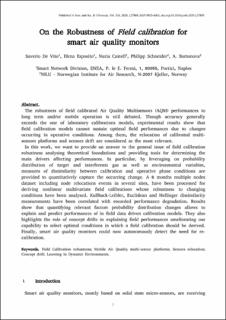| dc.contributor.author | De Vito, Saverio | |
| dc.contributor.author | Esposito, Elena | |
| dc.contributor.author | Castell, Nuria | |
| dc.contributor.author | Schneider, Philipp | |
| dc.contributor.author | Bartonova, Alena | |
| dc.date.accessioned | 2020-03-12T09:00:46Z | |
| dc.date.available | 2020-03-12T09:00:46Z | |
| dc.date.created | 2020-02-18T11:33:39Z | |
| dc.date.issued | 2020 | |
| dc.identifier.citation | Sensors and Actuators B: Chemical. 2020, 127869 | en_US |
| dc.identifier.issn | 0925-4005 | |
| dc.identifier.uri | https://hdl.handle.net/11250/2646494 | |
| dc.description.abstract | The robustness of field calibrated Air Quality Multi-sensors (AQM) performances to long term and/or mobile operation is still debated. Though accuracy generally exceeds the one of laboratory calibrations models, experimental results show that field calibration models cannot sustain optimal field performances due to changes occurring in operative conditions. Among them, the relocation of calibrated multi-sensors platforms and sensor drift are considered as the most relevant.
In this work, we want to provide an answer to the general issue of field calibration robustness assessement. Analysing theoretical foundations and providing tools for determining the calibration model validity domain. In particular, by leveraging the probability distribution of target and interferent gas as well as environmental variables, measures of dissimilarity between calibration and operative phase conditions are considered to quantitatively capture the occurring change. A 6 months multiple nodes dataset including node relocations events in several sites have been processed for deriving nonlinear multivariate field calibrations whose robustness to changing conditions have been analysed. Kullback-Leibler, Euclidean and Hellinger dissimilarity measurements have been correlated with recorded performance degradation. Results show that quantifying relevant factors probability distribution changes allows to explain and predict performances of in field data driven calibration models. They also highlight the role of concept drift in explaining field performances ameliorating our capability to select optimal conditions in which a field calibration should be derived. Finally, smart air quality monitors could now autonomously detect the need for re-calibration. | |
| dc.language.iso | eng | en_US |
| dc.rights | Attribution-NonCommercial-NoDerivatives 4.0 Internasjonal | * |
| dc.rights.uri | http://creativecommons.org/licenses/by-nc-nd/4.0/deed.no | * |
| dc.subject | Machine learning | |
| dc.title | On the Robustness of Field calibration for Smart air quality monitors | en_US |
| dc.type | Peer reviewed | en_US |
| dc.type | Journal article | en_US |
| dc.description.version | acceptedVersion | en_US |
| dc.rights.holder | © 2020 Elsevier B.V. All rights reserved. | en_US |
| dc.source.volume | 310 | en_US |
| dc.source.journal | Sensors and actuators. B, Chemical | en_US |
| dc.identifier.doi | 10.1016/j.snb.2020.127869 | |
| dc.identifier.cristin | 1795201 | |
| dc.relation.project | EC/FP7/308524 | en_US |
| dc.relation.project | NILU - Norsk institutt for luftforskning: 112099 | en_US |
| cristin.ispublished | true | |
| cristin.fulltext | postprint | |
| cristin.qualitycode | 1 | |

